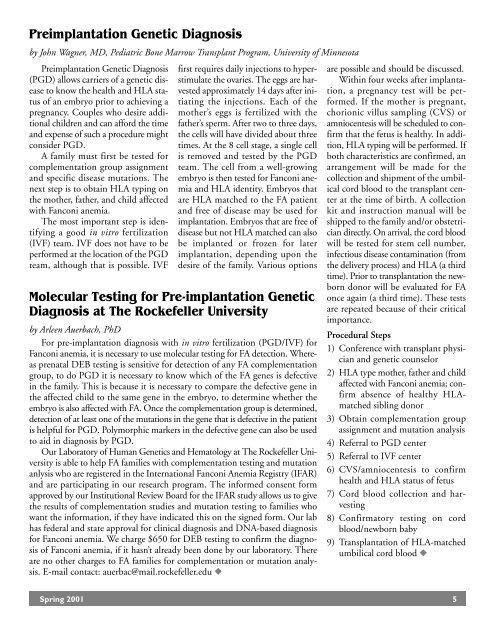FA Family News 3/01 - Fanconi Anemia Research Fund
FA Family News 3/01 - Fanconi Anemia Research Fund
FA Family News 3/01 - Fanconi Anemia Research Fund
Create successful ePaper yourself
Turn your PDF publications into a flip-book with our unique Google optimized e-Paper software.
Preimplantation Genetic Diagnosis<br />
by John Wagner, MD, Pediatric Bone Marrow Transplant Program, University of Minnesota<br />
Preimplantation Genetic Diagnosis<br />
(PGD) allows carriers of a genetic disease<br />
to know the health and HLA status<br />
of an embryo prior to achieving a<br />
pregnancy. Couples who desire additional<br />
children and can afford the time<br />
and expense of such a procedure might<br />
consider PGD.<br />
A family must first be tested for<br />
complementation group assignment<br />
and specific disease mutations. The<br />
next step is to obtain HLA typing on<br />
the mother, father, and child affected<br />
with <strong>Fanconi</strong> anemia.<br />
The most important step is identifying<br />
a good in vitro fertilization<br />
(IVF) team. IVF does not have to be<br />
performed at the location of the PGD<br />
team, although that is possible. IVF<br />
first requires daily injections to hyperstimulate<br />
the ovaries. The eggs are harvested<br />
approximately 14 days after initiating<br />
the injections. Each of the<br />
mother’s eggs is fertilized with the<br />
father’s sperm. After two to three days,<br />
the cells will have divided about three<br />
times. At the 8 cell stage, a single cell<br />
is removed and tested by the PGD<br />
team. The cell from a well-growing<br />
embryo is then tested for <strong>Fanconi</strong> anemia<br />
and HLA identity. Embryos that<br />
are HLA matched to the <strong>FA</strong> patient<br />
and free of disease may be used for<br />
implantation. Embryos that are free of<br />
disease but not HLA matched can also<br />
be implanted or frozen for later<br />
implantation, depending upon the<br />
desire of the family. Various options<br />
Molecular Testing for Pre-implantation Genetic<br />
Diagnosis at The Rockefeller University<br />
by Arleen Auerbach, PhD<br />
For pre-implantation diagnosis with in vitro fertilization (PGD/IVF) for<br />
<strong>Fanconi</strong> anemia, it is necessary to use molecular testing for <strong>FA</strong> detection. Whereas<br />
prenatal DEB testing is sensitive for detection of any <strong>FA</strong> complementation<br />
group, to do PGD it is necessary to know which of the <strong>FA</strong> genes is defective<br />
in the family. This is because it is necessary to compare the defective gene in<br />
the affected child to the same gene in the embryo, to determine whether the<br />
embryo is also affected with <strong>FA</strong>. Once the complementation group is determined,<br />
detection of at least one of the mutations in the gene that is defective in the patient<br />
is helpful for PGD. Polymorphic markers in the defective gene can also be used<br />
to aid in diagnosis by PGD.<br />
Our Laboratory of Human Genetics and Hematology at The Rockefeller University<br />
is able to help <strong>FA</strong> families with complementation testing and mutation<br />
anlysis who are registered in the International <strong>Fanconi</strong> <strong>Anemia</strong> Registry (I<strong>FA</strong>R)<br />
and are participating in our research program. The informed consent form<br />
approved by our Institutional Review Board for the I<strong>FA</strong>R study allows us to give<br />
the results of complementation studies and mutation testing to families who<br />
want the information, if they have indicated this on the signed form. Our lab<br />
has federal and state approval for clinical diagnosis and DNA-based diagnosis<br />
for <strong>Fanconi</strong> anemia. We charge $650 for DEB testing to confirm the diagnosis<br />
of <strong>Fanconi</strong> anemia, if it hasn’t already been done by our laboratory. There<br />
are no other charges to <strong>FA</strong> families for complementation or mutation analysis.<br />
E-mail contact: auerbac@mail.rockefeller.edu ◆<br />
are possible and should be discussed.<br />
Within four weeks after implantation,<br />
a pregnancy test will be performed.<br />
If the mother is pregnant,<br />
chorionic villus sampling (CVS) or<br />
amniocentesis will be scheduled to confirm<br />
that the fetus is healthy. In addition,<br />
HLA typing will be performed. If<br />
both characteristics are confirmed, an<br />
arrangement will be made for the<br />
collection and shipment of the umbilical<br />
cord blood to the transplant center<br />
at the time of birth. A collection<br />
kit and instruction manual will be<br />
shipped to the family and/or obstetrician<br />
directly. On arrival, the cord blood<br />
will be tested for stem cell number,<br />
infectious disease contamination (from<br />
the delivery process) and HLA (a third<br />
time). Prior to transplantation the newborn<br />
donor will be evaluated for <strong>FA</strong><br />
once again (a third time). These tests<br />
are repeated because of their critical<br />
importance.<br />
Procedural Steps<br />
1) Conference with transplant physician<br />
and genetic counselor<br />
2) HLA type mother, father and child<br />
affected with <strong>Fanconi</strong> anemia; confirm<br />
absence of healthy HLAmatched<br />
sibling donor<br />
3) Obtain complementation group<br />
assignment and mutation analysis<br />
4) Referral to PGD center<br />
5) Referral to IVF center<br />
6) CVS/amniocentesis to confirm<br />
health and HLA status of fetus<br />
7) Cord blood collection and harvesting<br />
8) Confirmatory testing on cord<br />
blood/newborn baby<br />
9) Transplantation of HLA-matched<br />
umbilical cord blood ◆<br />
Spring 20<strong>01</strong> 5

















